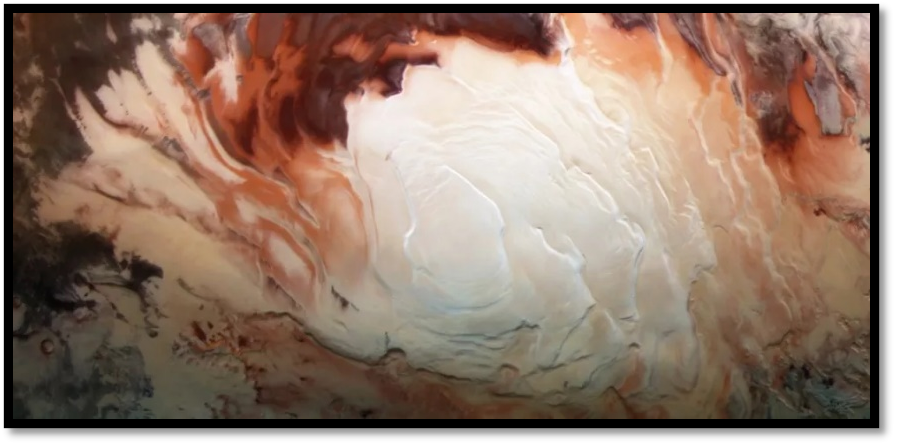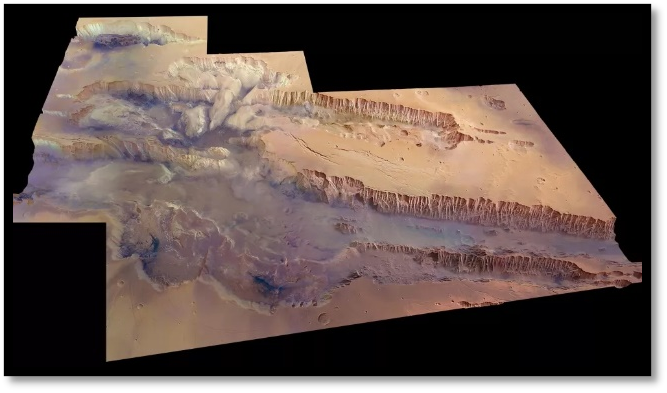Soil, water, fire, and wind: Where there’s energy, there’s life. Though a habitable planet supports life, Earth’s capacity to sustain life declines. The exponential rise in the population rate has led to a drastic disbalance in the availability, distribution, and utilization of natural and synthetic resources.
Aware of this harsh reality, scientists have been trying to come up with a solution for the existence of mankind, even if it demands inhabiting a new planet altogether. The Red Planet marks the top list. Let’s peak in and see if Mars is really the savior.
The reservoir of hidden water
A considerable amount of water has been found in the Valles Marineris canyon, the largest canyon in the solar system. Valles Marineris canyons are landscapes found along the Martian surface (Mars equator).
This discovery by “The European Space Agency’s ExoMars orbiter” is a game-changer that indicates the possibility of sustaining life on Mars. The discovered water is primarily in the form of ice and is believed to cover an area of approximately 15,830 square miles.
Alexey Malakhov, a scientist at the Space Research Institute of the Russian Academy of Sciences, also stated on this discovery, “We found a central part of Valles Marineris (Candor Chaos) to be packed full of water — far more water than we expected.”
Basically, an instrument called “Trace Gas Orbiter’s (TGO) Fine-Resolution Epithermal Neutron Detector (FREND)” detected a significant amount of hydrogen, along with oxygen, that forms water. One of the reasons Earth is habitable is the availability of water, an essential need of living organisms. The possibility of water prevalence on Mars hints at possible life on Mars in the past.
The prevalence of hydrated mineral streaks on Mars also shows the possibility of inhabiting the planet. Mars is smaller, has less gravity, and has a thick atmospheric blanket compared to Earth. This means that the water evaporated, and less of it came back on the surface of Mars, leaving behind salty streaks.
In 2011, these salty streaks, or Recurring Slope Lineae (RSL), were observed via a High-Resolution Imaging Science Experiment (HiRISE) camera aboard the Mars Reconnaissance Orbiter (MRO) and appeared dark in color. Though seen occasionally, they seemed to be salty water lakes running down the surface of the Red Planet.
Underground Lakes on Mars
Subsurface water at the Southern pole was another potential water source predicted to prevail on Mars. Scientists employed the European Mars Express spacecraft to confirm its presence, which used its Mars Advanced Radar for Subsurface and Ionosphere Sounding (MARSIS) for detecting the proposed water presence.
This technology basically works by penetrating a radar underground that sends pulses to the surface. The time taken for radar pulses to be reflected underground and reach back to the surface of Mars is observed. This technology enabled the discovery of three topographical bodies, interpreted as underground lakes, each of approximately 6 miles.
Moreover, further analysis of already existing data provided by MARSIS led scientists to conclude that there are multiple radar reflections just as those observed for the plausible underground lakes, but they cannot confirm if these bodies are actually underground frozen lakes. This uncertainty lies in the fact that these possible underground lakes are not frozen, which is confusing.

Aditya Khuller, a doctoral student at Arizona State University, and MARSIS co-principal investigator Jeffrey Plaut, of NASA’s Jet Propulsion Laboratory (JPL) in Southern California, are currently working on the mystery of the proposed underground lakes at Mars, intending to find concrete evidence that would explain the episodes of radar pulses.
Is there light at the end of the Tunnel?
Atmosphere comprising primarily carbon dioxide, approximately 40% of Earth’s gravity, small size, and cold temperatures (-63ºC) are premier reasons why inhabiting Mars is a challenge. In addition, the transition from Earth to Mars is an arduous task.
There are numerous questions: How could men construct colonies at Mars and obtain drinking water? How will men grow food for feeding the population? How would humans manage life at such a low temperature? The list of questions is never-ending.
Furthermore, it is not easy to land humans on Mars. The voyage can take around 150-300 days, depending on the distance between two planets at the time of launch and the viability and efficiency of rockets (fuel used, machinery needed, maintenance required).
The size of Mars restricts the number of living individuals it can support, which means that a mechanism is needed to classify the group of people that will end up on Mars. It is a tedious task to select individuals who will be given another chance at life on a new planet with the current population.
Ideally, the people landing on Mars should be skilled individuals with different backgrounds (scientists, engineers. doctors, teachers) with no underlying health conditions. The selection process of these individuals can cause chaos and unrest among the rest of the population.
Additionally, establishing a settlement viable for mankind at Mars is demanding. Brainstorming is needed to find ways to transport construction material to Mars, keeping in mind the pressure changes, temperature changes, radiation exposures, and other environmental conditions at Mars compared to Earth.
Growing plants and rearing animals is another challenge as the surface of Mars needs to be modified to support such activities. Hydroponics or aeroponics plants are an alternate, but in practical terms, their maintenance and acclimatization of the atmosphere at Mars to produce maximum output is complicated. A substantial amount of food reserves and oxygen supply is required till the former and latter are acquired on Mars.
Although there is evidence for water on Mars’s surface, the accessibility of water for human use is an area of expertise. Mainly, salty streaks of water are found to be purified for consumption. The amount of water readily available at Mars is not pure. This could pose a potential problem regarding water accessibility and utilization for the individuals who will colonize Mars.
A Step forward for finding potential solution for colonizing Mars
Scientists across the World and at NASA are stepping forward to find potential long-term solutions to the complications associated with inhabiting Mars. One of the initiatives is the MOXIE experiment on NASA’s Perseverance rover that aims to utilize the abundant carbon dioxide on Mars and convert it to oxygen for respiration.
Additionally, scientists are working on improving the range and sophistication of laboratory experiments and performing initial tests at Mars, especially on making the inhospitable areas of Mars hospitable.
For food production, scientists are gearing up to introduce particular microorganisms that photosynthesize in low natural illumination. This would create a great blend of gasses required for breathing.
At International Space Station (ISS), scientists are maneuvering potential functional microorganisms that have the tendency to survive and reproduce in climactic alien conditions as present on Mars.
Theoretically, the idea of colonizing and inhabiting Mars seems reasonably achievable, but practically it is far stretched. Numerous studies modified and upgraded technological developments, experimentation, and analysis are required to cross out all the concerns related to life on Mars. If mankind achieves its goals, it could undergo a tremendous living experience on a new planet.
“Only those who can see the invisible can do the impossible” – Jeffrey Fry.
References:
- https://www.space.com/mars-lakes-possible-underground-south-pole
- https://www.scientificamerican.com/article/buried-lakes-on-mars-may-just-be-frozen-clay/#:~:text=Bright%20reflections%20that%20radar%20detected,it%20does%20here%20on%20Earth.
- https://blogs.scientificamerican.com/observations/can-mars-be-made-habitable-in-our-lifetime/
- https://www.futurelearn.com/info/blog/is-mars-habitable-human-settlement
- https://www.planetary.org/articles/can-we-make-mars-earth-like-through-terraforming
- https://astronomy.com/news/2017/05/could-we-live-on-mars

Maira Masood is a BS Biosciences student at NUST, Pakistan. She aspires to be a geneticist and wants to play an active part in spreading scientific awareness through writings.


